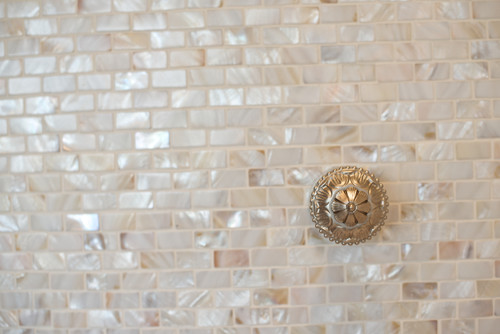Go for the Glow: Mother-of-Pearl Shines Around the Home
 Monday, July 8, 2013 at 9:52AM
Monday, July 8, 2013 at 9:52AM Article By: Ines Hanl
Mother-of-pearl has been used since ancient times to make people and their homes more beautiful, but today's manufacturing techniques have made this product even more accessible and economical. "Mother-of-pearl" is the common name for iridescent nacre, a blend of minerals secreted by oysters and other mollusks and deposited inside their shells; it coats and protects them from parasites and foreign objects.
Now we can use this wonderful material in our homes in a wide range of products. Mother-of-pearl tiles, wallpaper and countertops can adorn a space with the same elegance that a pearl necklace adds to an outfit. It's not cheap (mother-of-pearl tile starts at about $30 per square foot), but it can be just the splurge you need to set your project apart from the crowd.
Mosaic tile. Available in a wide range of natural hues, mother-of-pearl tile and mosaic blends are made from the nacre on shells like capiz, black lip, brown lip, paua and violet oyster.
White mother-of-pearl appears iridescent naturally, but it can be artifically tinted to almost any (sometimes shocking) color.
This is a beautiful example of mother-of-pearl on a kitchen backsplash. This shell tile is often thin, unless it's mounted to a thicker substrate, so if it's combined with another tile, it'll need to be built up to look flush.
If you're not sold on a shell product but love the iridescent look, look for manufacturers that produce iridescent glass mosaics. White iridescent glass can look quite similar to mother-of-pearl tiles.
Flooring. What a elegant mix of natural stone and mother-of-pearl! This application is a great example of layering textures in a white-on-white application. Note how the simple act of creating a border around a well-proportioned floor tile strengthens the grid pattern.
Mother-of-pearl can be used for walls, floor surfaces (make sure to check with the manufacturer) and sometimes outdoor applications.
Accents. If you are craving the glow but don't have the budget for a full iridescent wall, use mother-of-pearl mosaic tile to add a bit of sparkle to an accent. Mirror frames, side tables and table lamps can all shine with mother-of-pearl tile.
Inlay. Mother of pearl is a very suitable product to be cut into shapes. The cut shapes, called tesserae, are often used as inlay on furniture and other decorative home accessories.
Sinks. Shown here as a semivessel model, a mother-of-pearl mosaic sink, like those fromLinkaSink, can be cleaned with mild household cleaner or soap and water. The grout can be cleaned with grout cleaner; it should be sealed once or twice a year for maintenance.
Furnishings. Mother-of-pearl cabinetry faces utilize shell panels, rather than tile. These panels are laminated shell tiles and come in a variety of shell types, colors and sizes
Wall coverings. Maya Romanoff, who specializes in luxurious wall products, offers a flexible tile that can be applied like a wallpaper. The tile is a thin capiz shell veneer applied to backing paper with a topcoat for easy maintenance. York Wallcoverings and Franco Ferrucci offer similar products.
Maya Romanoff's wallpaper starts at $45 per square foot (plus installation). Candice Olson's mother-of-pearl wallpaper starts at about $110 per double roll (about 60 feet of wallpaper).
Mother-of-pearl accents bring a wonderful glow to Icestone countertops, enlivening a space in a calm way. The use of small pieces of glass doesn't feel as aggressive as in some other products.
From personal experience, I recommend using Icestone only in areas where there's no risk of staining the surface. I've used Icestone quite successfully in bathrooms and laundry areas.
Icestone countertops are comparable to mid- to high-end granite in cost. Allow for about $150 per square foot (including installation) in you.



























Reader Comments